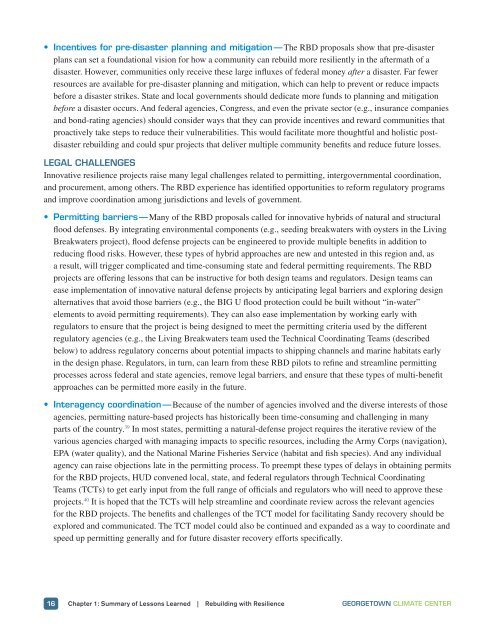Rebuilding with Resilience
dw0r306aHfX
dw0r306aHfX
You also want an ePaper? Increase the reach of your titles
YUMPU automatically turns print PDFs into web optimized ePapers that Google loves.
• Incentives for pre-disaster planning and mitigation — The RBD proposals show that pre-disaster<br />
plans can set a foundational vision for how a community can rebuild more resiliently in the aftermath of a<br />
disaster. However, communities only receive these large influxes of federal money after a disaster. Far fewer<br />
resources are available for pre-disaster planning and mitigation, which can help to prevent or reduce impacts<br />
before a disaster strikes. State and local governments should dedicate more funds to planning and mitigation<br />
before a disaster occurs. And federal agencies, Congress, and even the private sector (e.g., insurance companies<br />
and bond-rating agencies) should consider ways that they can provide incentives and reward communities that<br />
proactively take steps to reduce their vulnerabilities. This would facilitate more thoughtful and holistic postdisaster<br />
rebuilding and could spur projects that deliver multiple community benefits and reduce future losses.<br />
LEGAL CHALLENGES<br />
Innovative resilience projects raise many legal challenges related to permitting, intergovernmental coordination,<br />
and procurement, among others. The RBD experience has identified opportunities to reform regulatory programs<br />
and improve coordination among jurisdictions and levels of government.<br />
• Permitting barriers — Many of the RBD proposals called for innovative hybrids of natural and structural<br />
flood defenses. By integrating environmental components (e.g., seeding breakwaters <strong>with</strong> oysters in the Living<br />
Breakwaters project), flood defense projects can be engineered to provide multiple benefits in addition to<br />
reducing flood risks. However, these types of hybrid approaches are new and untested in this region and, as<br />
a result, will trigger complicated and time-consuming state and federal permitting requirements. The RBD<br />
projects are offering lessons that can be instructive for both design teams and regulators. Design teams can<br />
ease implementation of innovative natural defense projects by anticipating legal barriers and exploring design<br />
alternatives that avoid those barriers (e.g., the BIG U flood protection could be built <strong>with</strong>out “in-water”<br />
elements to avoid permitting requirements). They can also ease implementation by working early <strong>with</strong><br />
regulators to ensure that the project is being designed to meet the permitting criteria used by the different<br />
regulatory agencies (e.g., the Living Breakwaters team used the Technical Coordinating Teams (described<br />
below) to address regulatory concerns about potential impacts to shipping channels and marine habitats early<br />
in the design phase. Regulators, in turn, can learn from these RBD pilots to refine and streamline permitting<br />
processes across federal and state agencies, remove legal barriers, and ensure that these types of multi-benefit<br />
approaches can be permitted more easily in the future.<br />
• Interagency coordination — Because of the number of agencies involved and the diverse interests of those<br />
agencies, permitting nature-based projects has historically been time-consuming and challenging in many<br />
parts of the country. 39 In most states, permitting a natural-defense project requires the iterative review of the<br />
various agencies charged <strong>with</strong> managing impacts to specific resources, including the Army Corps (navigation),<br />
EPA (water quality), and the National Marine Fisheries Service (habitat and fish species). And any individual<br />
agency can raise objections late in the permitting process. To preempt these types of delays in obtaining permits<br />
for the RBD projects, HUD convened local, state, and federal regulators through Technical Coordinating<br />
Teams (TCTs) to get early input from the full range of officials and regulators who will need to approve these<br />
projects. 40 It is hoped that the TCTs will help streamline and coordinate review across the relevant agencies<br />
for the RBD projects. The benefits and challenges of the TCT model for facilitating Sandy recovery should be<br />
explored and communicated. The TCT model could also be continued and expanded as a way to coordinate and<br />
speed up permitting generally and for future disaster recovery efforts specifically.<br />
16 Chapter 1: Summary of Lessons Learned | <strong>Rebuilding</strong> <strong>with</strong> <strong>Resilience</strong> GEORGETOWN CLIMATE CENTER


